HSPA9
-
Official Full Name
heat shock 70kDa protein 9 (mortalin)
-
Overview
This gene encodes a member of the heat shock protein 70 gene family. The encoded protein is primarily localized to the mitochondria but is also found in the endoplasmic reticulum, plasma membrane and cytoplasmic vesicles. This protein is a heat-shock cognate protein. This protein plays a role in cell proliferation, stress response and maintenance of the mitochondria. A pseudogene of this gene is found on chromosome 2. -
Synonyms
HSPA9; heat shock 70kDa protein 9 (mortalin)provided by HGNC; CSA; MOT; MOT2; GRP75; PBP74; GRP-75; HSPA9B; MGC4500; MTHSP75; stress-70 protein, mitochondrial; heat shock 70kDa protein 9 (mortalin);
- Recombinant Proteins
- Cell & Tissue Lysates
- Protein Pre-coupled Magnetic Beads
- Chicken
- Human
- Mouse
- Zebrafish
- E.coli
- HEK293
- HEK293T
- In Vitro Cell Free System
- Mammalian Cell
- Mammalian cells
- Sf9 Insect Cell
- Wheat Germ
- Flag
- GST
- His
- His (Fc)
- Avi
- MYC
- DDK
- N/A
- N
- Background
- Quality Guarantee
- Case Study
- Involved Pathway
- Protein Function
- Interacting Protein
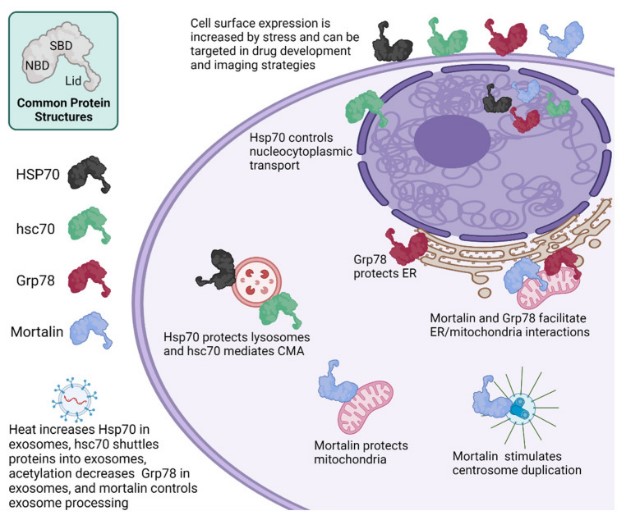
Fig1. Major areas of cell protection by various HSP70 proteins. (Rajani Rai, 2021)
What is HSPA9 protein?
HSPA9 (heat shock protein family A (Hsp70) member 9) gene is a protein coding gene which situated on the long arm of chromosome 5 at locus 5q31. This gene encodes a member of the heat shock protein 70 gene family. The encoded protein is primarily localized to the mitochondria but is also found in the endoplasmic reticulum, plasma membrane and cytoplasmic vesicles. This protein is a heat-shock cognate protein. This protein plays a role in cell proliferation, stress response and maintenance of the mitochondria. The HSPA9 protein is consisted of 679 amino acids and its molecular mass is approximately 73.7 kDa.
What is the function of HSPA9 protein?
HSPA9 protein, also known as HSP70 family member 9 or HSP70-9, is a molecular chaperone belonging to the heat shock protein 70 family. Its main functions include: 1) to help protein folding and assembly; 2) Prevent protein aggregation; 3) Promote the degradation of misfolded or damaged proteins; 4) Participate in cellular stress reactions, such as heat shock, oxidative stress, etc.; 5) Regulate cell signal transduction and gene expression; 6) Participate in immune responses, such as antigen presentation and immune cell activation
HSPA9 Related Signaling Pathway
HSPA9 is involved in a variety of signaling pathways, including: 1) heat shock response: As a molecular chaperone, HSPA9 is involved in the regulation of the heat shock protein family to help cells cope with heat shock and other stress conditions; 2) ER stress: HSPA9 plays a key role in ER stress, maintaining the correct folding and transport of proteins; 3) Inflammatory response: HSPA9 can regulate the production and release of inflammatory factors and participate in the regulation of inflammatory response; 4) Immune response: HSPA9 plays a role in antigen presentation and activation of immune cells, and is involved in the regulation of the immune system.
HSPA9 Related Diseases
HSPA9 protein is closely related to many diseases. In terms of tumor, HSPA9 is involved in the proliferation, invasion and metastasis of tumor cells, and is related to the occurrence and development of liver cancer, stomach cancer, colorectal cancer and other cancers. In addition, HSPA9 also plays a role in neurodegenerative diseases, such as Alzheimer's disease, Parkinson's disease, etc. In cardiovascular diseases, HSPA9 is associated with the occurrence and development of myocardial ischemia, myocardial infarction and other diseases. In addition, HSPA9 is also associated with the occurrence and development of diabetes, kidney disease, inflammatory diseases and other diseases.
Bioapplications of HSPA9
Changes in the expression level of HSPA9 in some diseases make it a potential diagnostic marker for the early detection and monitoring of diseases. Given the role of HSPA9 in antigen presentation and activation of immune cells, its application in vaccine design and development is also being explored, especially for certain types of cancer vaccines.
High Purity
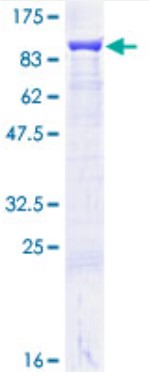
Fig1. SDS-PAGE (HSPA9-5113H) (PROTOCOL for western blot)
.
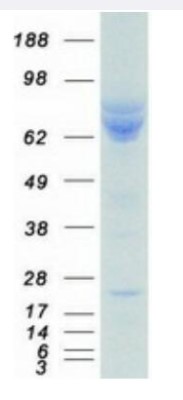
Fig2. SDS-PAGE (HSPA9-477HFL) (PROTOCOL for western blot)
Case Study 1: Paulo Roberto Dores-Silva, 2020
Mitochondrial Hsp70 (HSPA9, mtHsp70, mortalin) in conjunction with a complex set of other proteins is involved in the transport of polypeptides across the mitochondrial matrix. This observation allows us to hypothesize that HSPA9 might interact with membranes directly, similarly to other Hsp70s. Thus, the researchers investigated whether human HSPA9 could also get inserted into lipid membranes. Human HSPA9 was incubated with liposomes made of lipids found within the mitochondrial membrane, such as 1', 3'-bis [1, 2-dimyristoyl-sn-glycero-3-phospho]-glycerol (CL), palmitoyl-oleoyl phosphocholine (POPC), palmitoyl-oleoyl phosphoserine (POPS), and palmitoyl-oleoyl phosphoethanolamine (POPE). HSPA9 displayed a predilection for CL and POPS, and low affinity for POPC and POPE, suggesting that the proteins have high specificity for negatively charged phospholipids. Then, liposomes were made with a composition resembling either the outer or inner mitochondrial membrane (OMM or IMM, respectively). They observed that HSPA9 has a higher affinity for IMM than OMM, which is consistent with the higher content of CL in the IMM. A comparison for the incorporation into POPS or CL liposomes by HSPA9 or HSPA1 indicated that both proteins behaved very similarly when exposed to CL liposomes, but differently with POPS liposomes, which was further corroborated by their susceptibility to proteinase K digestion after incorporation into liposomes.
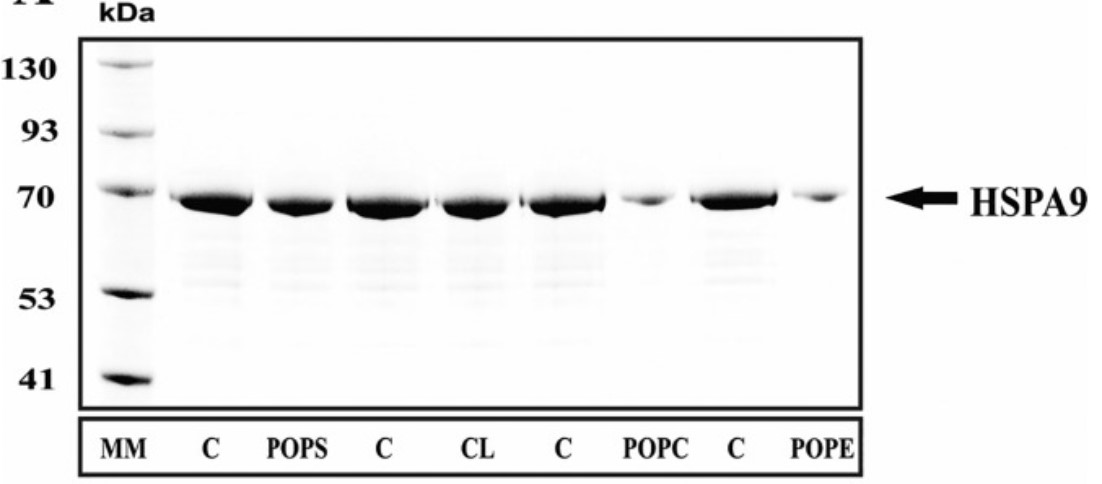
Fig1. Interaction of human HSPA9 with phospholipid liposomes.
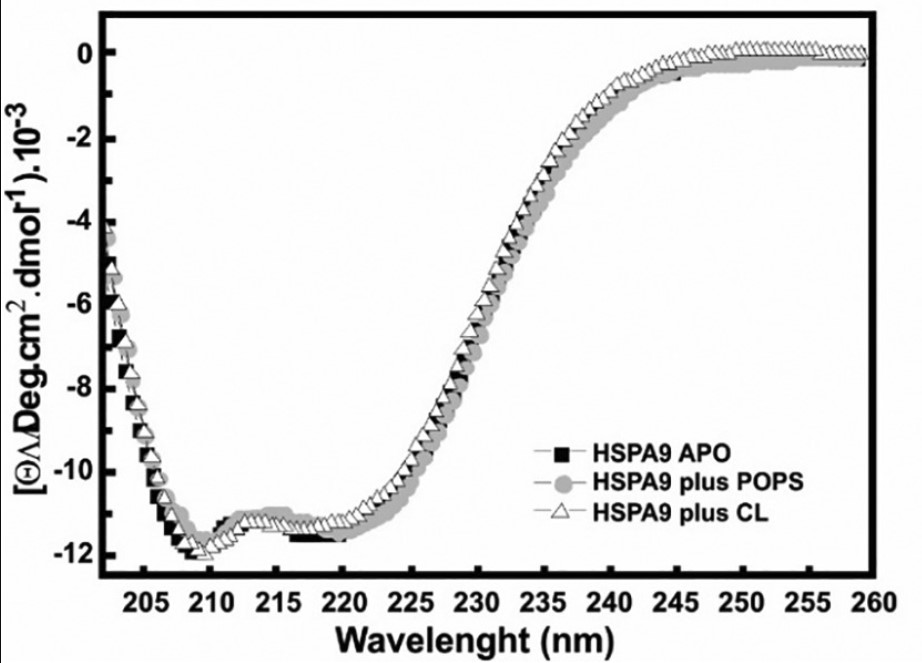
Case Study 2: D Starenki, 2015
Medullary thyroid carcinoma (MTC) is a neuroendocrine tumor mainly caused by mutations in the rearranged during transfection (RET) proto-oncogene. For therapy of advanced MTC, the Food and Drug Administration recently approved vandetanib and cabozantinib, the tyrosine kinase inhibitors targeting RET, vascular endothelial growth factor receptor, epidermal growth factor receptor and/or c-MET. Nevertheless, not all patients respond to these drugs, demanding additional therapeutic strategies. The researchers found that mortalin (HSPA9/GRP75), a member of HSP70 family, is upregulated in human MTC tissues and that its depletion robustly induces cell death and growth arrest in MTC cell lines in culture and in mouse xenografts. These effects were accompanied by substantial downregulation of RET, induction of the tumor-suppressor TP53 and altered expression of cell cycle regulatory machinery and apoptosis markers, including E2F-1, p21(CIP1), p27(KIP1) and Bcl-2 family proteins. The investigation of the molecular mechanisms underlying these effects revealed that mortalin depletion induces transient MEK/ERK (extracellular signal-regulated kinase) activation and altered mitochondrial bioenergetics in MTC cells, as indicated by depolarized mitochondrial membrane, decreased oxygen consumption and extracellular acidification and increased oxidative stress.
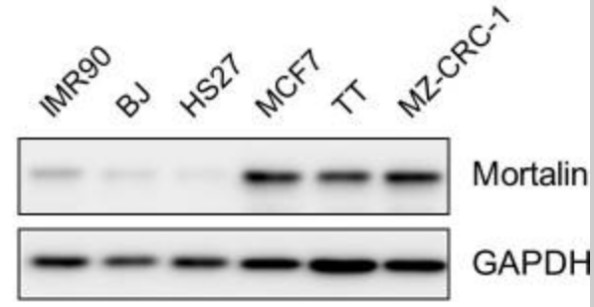
Fig3. Western blot analysis of mortalin expression in total cell lysates of the human MTC cell lines, TT and MZ-CRC-1.
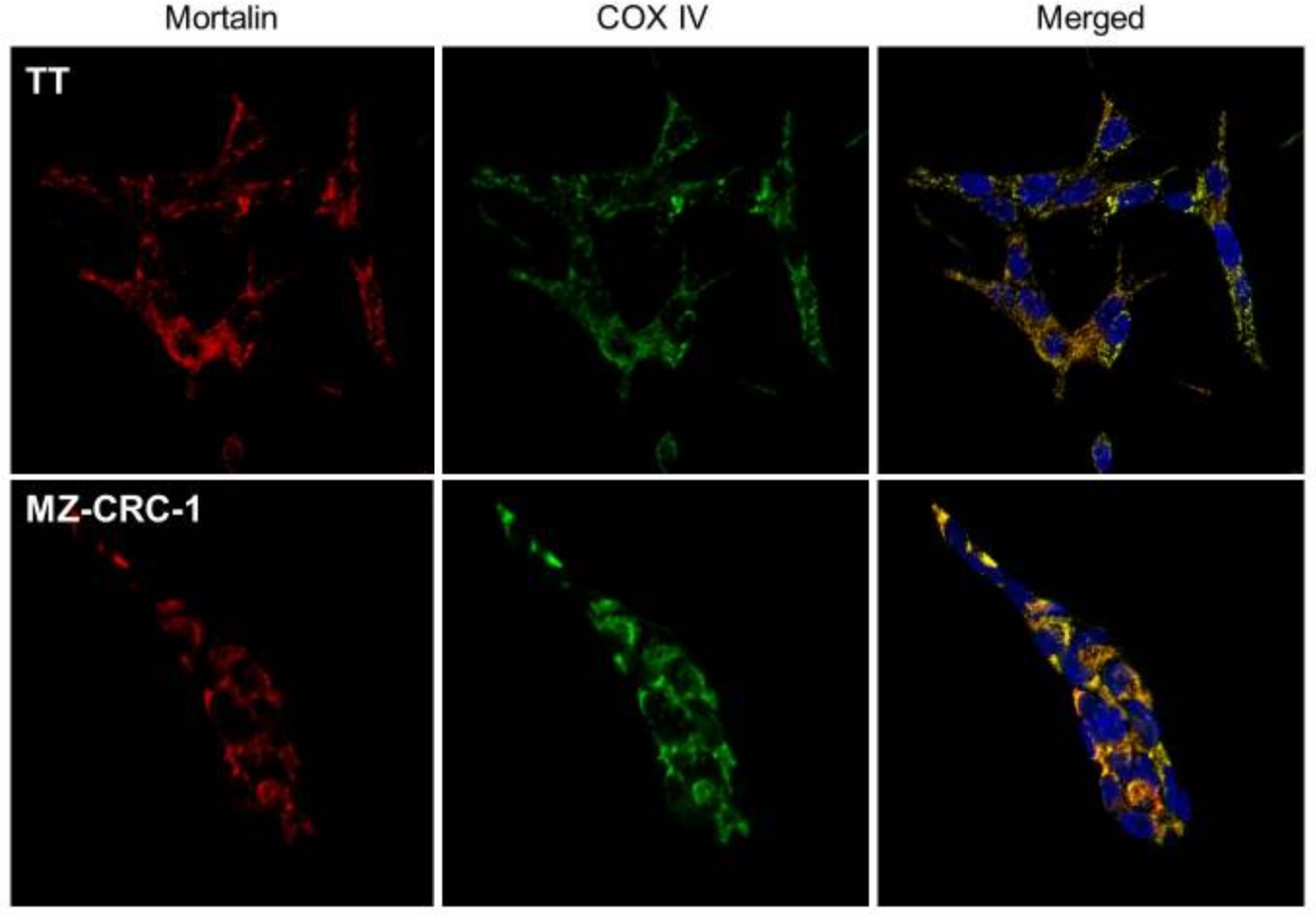
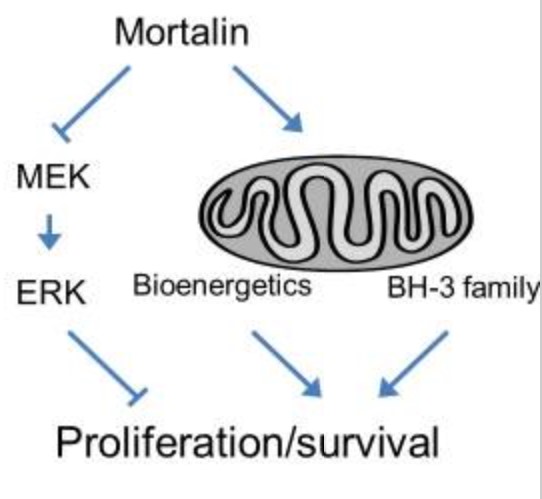
Fig1. Mortalin affects proliferation and survival of MTC cells by regulating the MEK/ERK pathway and mitochondrial metabolism in MTC cells. (D Starenki, 2015)
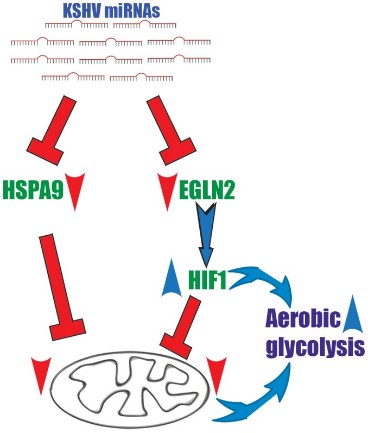
Fig2. A two-armed mechanism model by which KSHV changes cellular energy metabolism. (Ohad Yogev, 2014)
HSPA9 involved in several pathways and played different roles in them. We selected most pathways HSPA9 participated on our site, such as RNA degradation, Tuberculosis, which may be useful for your reference. Also, other proteins which involved in the same pathway with HSPA9 were listed below. Creative BioMart supplied nearly all the proteins listed, you can search them on our site.
| Pathway Name | Pathway Related Protein |
|---|---|
| RNA degradation | LSM5;CNOT1;groL;SKIV2L;ENO1B;WDR61;PAN3;PABPC4;DIS3 |
| Tuberculosis | FCGR3;IL12A;TLR4;HLA-DRB4;HSPD1;TNFRSF1A;CAMK2B;PPP3CB;APAF1 |
HSPA9 has several biochemical functions, for example, ATP binding, fibroblast growth factor binding, heat shock protein binding. Some of the functions are cooperated with other proteins, some of the functions could acted by HSPA9 itself. We selected most functions HSPA9 had, and list some proteins which have the same functions with HSPA9. You can find most of the proteins on our site.
| Function | Related Protein |
|---|---|
| ATP binding | PDK1;MAPKAPK2A;TBCK;ERCC6L2;NTRK2;XYLB;FGFR1A;ICK;ABCB11 |
| fibroblast growth factor binding | CXCL13;RPS2;CEP57;FIBPB;SCN5A;RPS19;FGFR1A;THBS1;FGFR1 |
| heat shock protein binding | DLST;EEF1D;DNAJA2L;TOMM34;FKBP4;SSUH2RS1;GM5506;IRAK1;BAX |
| poly(A) RNA binding | ZC3H10;TPT1;DNTTIP2;DDX42;ZNF346;FAM120B;GANAB;ALKBH5;TCOF1 |
| protein binding | CHRD;ZC3H10;CSRP2BP;ZBTB5;STT3A;CDPF1;TDG;ACTR6;RYBP |
| ubiquitin protein ligase binding | PRDX6;RNF20;HSPA1A;CASP10;AKTIP;DNAJA1;SPOP;UBE2H;HDAC6 |
| unfolded protein binding | DNAJA3;LMAN1;PFDN5;DNAJB2;CALRL2;GRXCR2;DNAJA3B;GRPEL1;CRYAA |
HSPA9 has direct interactions with proteins and molecules. Those interactions were detected by several methods such as yeast two hybrid, co-IP, pull-down and so on. We selected proteins and molecules interacted with HSPA9 here. Most of them are supplied by our site. Hope this information will be useful for your research of HSPA9.
TP53; EGFR; TP73
- Q&As
- Reviews
Q&As (7)
Ask a questionEnvironmental stressors like heat shock and toxins alter HSPA9 expression, impacting its protective roles in cells.
HSPA9 influences immune cell functionality and modulates inflammatory responses, impacting immune regulation.
HSPA9 is implicated in neurodegenerative diseases, potentially affecting protein misfolding and mitochondrial dysfunction.
Dysregulation of HSPA9 can lead to enhanced cancer cell proliferation and survival, affecting tumor growth.
HSPA9 plays a role in cellular aging by influencing mitochondrial function and stress response mechanisms.
HSPA9 cooperates with other chaperones in protein folding and prevents harmful protein aggregation.
HSPA9 is essential for mitochondrial function and helps cells respond to stress by regulating mitochondrial integrity and signaling.
Customer Reviews (3)
Write a reviewQuick and reliable protein sequencing; invaluable for our work.
High-quality protein crystallography services; exceptional results.
Critical expertise in protein engineering; unmatched service quality.
Ask a Question for All HSPA9 Products
Required fields are marked with *
My Review for All HSPA9 Products
Required fields are marked with *


